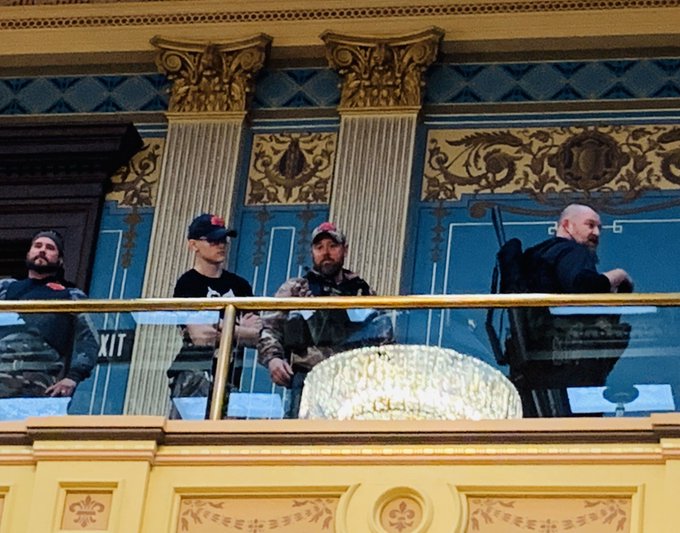They were scenes that shocked even those who thought they had a good understanding of US gun culture.
The anti-lockdown protesters who occupied the Michigan State House in Lansing last week brought with them not just chants and placards.
Some came armed with assault weapons and ammunition belts.
It
was if they were getting ready to invade a small country instead of
just taking part in what was, in the end, largely a peaceful
demonstration.
As it turns out, the constitutional right to bear arms is particularly sweeping in Michigan.
Directly above me, men with rifles yelling at us. Some of my colleagues who own bullet proof vests are wearing them. I have never appreciated our Sergeants-at-Arms more than today. #mileg

It is perfectly legal to carry weapons in public
spaces in that state, mainly because there aren't any laws in place
explicitly saying you can't.
Therefore, the hands of local police were tied.
Can
you imagine similar scenes at any of Australia's state parliament
houses? Of course, we never have to. Gun ownership is not as entrenched
in Australia.
But, as a new book explains, that hasn't always been the case.
Space to play or pause, M to mute, left and right arrows to seek, up and down arrows for volume.

Australian and US paths converge
Under
Fire: How Australia's Violent History Led To Gun Control by
Hobart-based historian Nick Brodie takes us on a journey through this
country's violent past.
It presents a few sliding
door moments where we took a radically different path to America when it
comes to gun ownership. And a lot of them came well before Port Arthur.

Gunfire
did mark many of our most significant moments, starting with Captain
Cook's landing party in April 1770 firing on two Indigenous men on the
shores of Botany Bay.
"Guns were crucial in terms of affecting the colonial project," notes Brodie.
"Not
just the technological advantage they provided the settlers, which
enabled them to win war after war, but they also used the law of gun
restriction against Aboriginal people to deny them the ability to carry
guns and fight back on the same terms."
The ban on
Indigenous people owning guns was part and parcel of the wider process
of systematic dispossession, just as firearms were integral to
maintaining order in the new European settlement.

It is here the histories of Australia and the US converge.
Both countries have colonial origins with violent beginnings.
Gun
ownership in Australia in the early days was widespread. In fact, as
Brodie points out, the powerful US National Rifle Association was
predated by similar associations in the Australian colonies in the
middle of the 19th Century.
The idea was British subjects "should be ready to bear arms for the nation".
US once led the way in gun control
Our
gun-toting histories collided during the goldrush of the 1850s with the
arrival to Australia of a number of well-armed Californians who
proceeded to get on the wrong side of the law.
Guns were freely used as weapons of self-defence on the goldfields, with bushrangers always on the prowl.
Australia
was a country awash with firearms, and it wasn't long before
legislatures sought to impose gun control measures. Some worked. Others
were simply ignored.

Gun ownership jumped dramatically at the end of the First World War, when the Diggers came home with their trusted pistols.
Brodie says there was a national "pistol crisis", with criminal elements quickly getting their hands on the guns.
A
select committee was assembled to investigate the problem, and it even
heard from a US diplomatic consul who pointed to the gun-licencing
regime in New York as a model for the Australians to consider.
What followed this outbreak of gun violence, and others in subsequent decades, were even tighter gun laws.
Brodie says the gun cultures in Australia and the US really started diverging after the Second World War.
"But after
World War II, the major gun manufacturers turned assault weapons into
hunting rifles, and so there's a big market element there.
"Because Australia doesn't have gun manufacturers on the same level, it is a bit of a different story."
A culture of gun violence grew in America while Australia largely went the other way.
The trauma of Port Arthur ushered in sweeping new gun laws as well as a widely successful gun amnesty and buy-back scheme.
Space to play or pause, M to mute, left and right arrows to seek, up and down arrows for volume.

It was during those dark days after the massacre that Brodie says the nation agreed, "The age of the firearm had to end".
All of which brings us back to the armed militia in Michigan.
Looking at our shared histories with guns, it appears Australia stepped back from the brink.


No comments:
Post a Comment